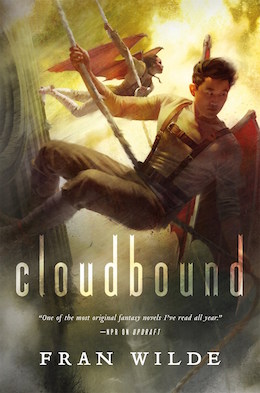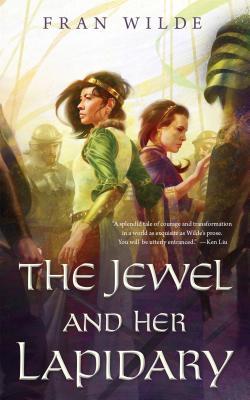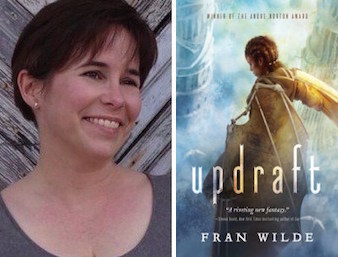Fran Wilde made history with her debut novel, Updraft. It was the first novel to be nominated for both the Nebula Best Novel Award and the Andre Norton Award. It went on to win the Norton, and also to win the Compton Crook Award—a pretty impressive start to a novel-writing career.
I really enjoyed Updraft. I enjoyed its sequel, Cloudbound (just out from Tor Books) even more. But if you’re not yet ready to give them a chance, well, the author herself has graciously agreed to answer a few questions about books, wings, writers, and shenanigans…
LB: I used to open each of these Q&A sessions by asking about women in genre. But I’m a little tired of constantly asking that question, so I think I’ll just ask you WHAT IS THE MOST AWESOME THING IN YOUR BOOKS?
 FW: That’s a really hard question for me to answer because I’m writing them, so I’m looking at everything with a very critical eye. (Who am I kidding, I look at everything I do that way. Make breakfast? Critical eye. The eggs could have used slightly more Old Bay, less hatch chilies… etc.)
FW: That’s a really hard question for me to answer because I’m writing them, so I’m looking at everything with a very critical eye. (Who am I kidding, I look at everything I do that way. Make breakfast? Critical eye. The eggs could have used slightly more Old Bay, less hatch chilies… etc.)
And what I like best one day is different the next—I love the layers of the Bone Universe. The fact that there are different eras and different perspectives on each era. It’s not a monostory by any stretch of the imagination. I am very happy most of the time with my monsters (I love making monsters). The skymouths in particular have gone from being a terrifying opening scene to an important part of the ecosystem. The bone eaters in Cloudbound are even more complex, and, in the right light—at an angle, possibly dimmed to almost darkness—very beautiful.
The characters—Kirit, Nat, Wik, Ciel & Moc, Ezarit & Elna, and the rest are also favorites. That’s a good thing, because I spend a lot of time with them. I like how much they are different from one another, how their world has shaped them each differently and that they’re all okay with that, mostly!
What I love most about my books is the wind. When I’m writing them I can hear the air currents and feel them shifting around me. I notice when the wind is gone too. There are points where, when I’m out walking, thinking about a scene, a breeze might toy with the edge of my coat, and I feel like I’m about to lift. Or I’ll be sitting out on my porch, watching a storm roll in, and feeling the winds spin all around me. I love that in real life and it’s been wonderful to be part of making that real in my books. I guess that means I love the wings too, because the wings are a way of interpreting the wind. So, yes, all of that!
LB: Wings. Wind. Why flying? It’s such a central part of Updraft and Cloudbound. What makes a good set of wings, and would you ever trust yourself to a pair in the real world?
FW: Why flying?
It seems like a good way to get around above the clouds, doesn’t it? Sure, there are bridges in Updraft and Cloudbound, but those are tower-to-tower. Flying is all directions, as long as there’s wind.
What makes a good set of wings, and would you ever trust yourself to a pair in the real world?
How much geek rabbit-hole research do you want? I have buckets on this subject. People have been building man-made wings and jumping off of towers trying to fly since there have been people and towers. What we’ve learned over the years is that a good set of wings also needs something to help hold your feet up, so you’re not trying to fly at a leg-breaking angle. (History is riddled with “and jumped, and fell, and broke both legs” admonishments.) Among the first to reportedly fly successfully with that accommodation was a polymath from the Ottoman Empire: Hezârfen Ahmed Çelebi.
For a good set of wings, you want something light, but sturdy, and you want some control. And there’s a difference between bird-like wings (which flap, supposedly, though mostly on YouTube pranks) and gliders—like Çelebi’s, Leonardo DaVinci’s, Otto Lilienthal’s, and the Wright Brothers’ wings, and modern-day hang-gliders and wingsuits.
Depending on the day, and my mood, sure, I’d give wings a try. I love the idea of soaring, and the fact of wind catching a foil to create lift is one of my favorite bits of physics, aerodynamics, and engineering.
LB: You’ve written shorter works as well, including the novella The Jewel and Her Lapidary for Tor.com Publishing. Tell us a little about the inspiration behind that story, and how you came up with the whole jewel-lapidary sanity-madness connection?
 FW: The Jewel and Her Lapidary began as a short story (this happens with me a lot. Updraft also started as a short story), because I wanted to write about power, friendship, and societal expectations. I’d been writing sketches in the gem universe for a year or so when JEWEL began presenting itself, and I revised it for two years before the travel guide sections gave me new insights about what I was doing. Framing it as a hidden history let me look at those issues, as well as the ones you mention, from a larger perspective of what gets remembered and who gets forgotten.
FW: The Jewel and Her Lapidary began as a short story (this happens with me a lot. Updraft also started as a short story), because I wanted to write about power, friendship, and societal expectations. I’d been writing sketches in the gem universe for a year or so when JEWEL began presenting itself, and I revised it for two years before the travel guide sections gave me new insights about what I was doing. Framing it as a hidden history let me look at those issues, as well as the ones you mention, from a larger perspective of what gets remembered and who gets forgotten.
Regarding the jewel-lapidary sanity-madness connection: in my mind it’s not a 1:1-1:1 relationship with those themes, in that I’m not setting up the Jewels as a paradigm of sanity. At a point in the past in the Jeweled Valley, it became apparent that having rulers who could not only hear and amplify the powers of these gems—which are pretty mind-bending—wasn’t a good idea for the region, but the strength and capability of those who could hear the gems was undeniable. So the region split the responsibility for the kingdom between two groups… And by the time we get to the period in the story, that balance of power has begun sliding into serious imbalance.
LB: The relationship between the two young women—the titular Jewel and her Lapidary, Lin and Sima—in that story is very close. One could read it as romantic, though it is equally open to other readings. In that light, and in light of the way the story ends (no spoilers!) did you intend for it to be read romantically? What do you think about queer representation in the genre? It’s been a big discussion in the genre in the last while, in light of a number of stories with queer representation that ended quite tragically.
FW: I think Lin and Sima are at a point where they’ve been put very much together to the exclusion of all else, where they are working out power balances, loyalties, and the rules each must live by that have been imposed on them by their world, as well as the narrative hypocrisies of that world. They both care about each other very much and are at the same time working out the balances of that relationship. It was important to me throughout that both of their characters had agency and full emotional range more than anything, and that they made decisions for themselves in light of all the decisions that had been previously made for them.
Representation of a world as complex and diverse as the one I live in, and the one I want to live in, is something I’m always going to aspire to, with an express aim of not trying to take others’ experiences over.
Regarding tragedy: I’m pretty equally mean to my characters, but I try to let them live now and then too. Specifically to your question, one of the things that bothers me tremendously with tragic endings is the flagrant “misguided arrow” or “shot through the window” character send-off. Especially because is too readily applied to characters on the margins. It denies those characters agency and a true ending to their own story arc. It takes their choices away from them.
LB: Next question! What do you consider your influences, when it comes to writing?
FW: My literary influences are pretty broad—poets, essayists, fiction authors. Borges, Calvino, Marquez, Mieville, and Achebe are high on the list, as are Cadigan, Gibson, and Stephenson. Milton comes into it, Shelley. Hopkins, Neruda, Szymborska, Rukeyser, Bishop, Heaney, Dove, Boland, My teachers—especially Heather McHugh, Larry Levis, Rita Dove, Elizabeth Bear, Steven Gould, Nancy Kress, Walter Jon Williams. Also, absolutely Frank Herbert, Flannery O’Connor, Isaac Asimov, and Ann McCaffrey. Non fiction, science writers like John McPhee, David Quammen, and E.O. Wilson.
LB: Tell us a little about why these, in particular, have influenced you?
FW: Oh gosh. In the case of the first five, they taught me how to unfold what I see and experience it, and fold it again in new ways. The second three taught me how to hack that. The rest gave me words in an order that had rhythm to it, they gave me different ways of seeing and hearing things. And they all went out into the world and came back carrying strange stories to share. Reading what they, and so many other authors besides, write recharges me.
And let me add four others. Norton Juster, Lloyd Alexander, Ursula Le Guinn, and Natalie Babbitt.
They taught me wonder.
LB: What other (women) writers working in the genre right now do you recommend? Tell us a little about why.
FW: Sharing this list this while knowing I’m missing a great number of people is nerve-wracking, but I’ll give it a go: Ada Palmer, Aliette de Bodard, Frances Hardinge, N.K. Jemisin, Elizabeth Bear, Jo Walton, Lindsay Faye, Mary Robinette Kowal, Kate Elliot, Alyssa Wong, Sarah Pinsker, AC Wise, Rose Lemberg, Foz Meadows, Siobhan Carroll, Nisi Shawl, Catherynne M. Valente, Nicky Drayden, Kat Howard, Delia Sherman, Nalo Hopkinson, Theodora Goss, Shveta Thakrar, Carolyn Ives Gillman, Justina Ireland, Sarah Beth Durst, Zen Cho, Delilah Dawson, K.M. Ferebee, Genevieve Valentine, E. Catherine Tobler, Lara Elena Donnelly, Kelly Robson, Alyx Dellmonica, Roshani Chokshi, Ann Leckie—just to name a few—in part because in the past year they’ve written something that’s grabbed me, and in part because they’ve all created distinct voices within the genre—short and long form—and their worlds and stories are so darn vivid.
LB: So, before we wrap up, tell us a little about what drew you to the literature of the fantastic in the first place?
FW: My imagination has always fallen a little outside of scope. When I began reading fantastic literature—very early, thank goodness—I started realizing that thinking “weird” was not only accepted in some places, but actively encouraged. I liked that a lot and gravitated to books and movies, events and authors where that was true.
I loved how reading fantastic literature informed my life, my creative outlets, my conversations, even when I wasn’t reading.
When you go to a museum that hangs work in relation to other work—like the Barnes Foundation in Philadelphia, which I also connected with at a pretty young age—you see a number of images and eras in collaboration with one another. Then, as you move between masterpieces, you start making connections and having ideas in the liminal space. That’s a bit like what reading in the fantastic was for me. A lot of concepts, myths, and philosophies with enough space between them for my own ideas.
LB: Last question: What are you working on now? What’s coming next for you?
FW: Last week, I turned in to my editor Miriam Weinberg the first draft of Horizon (the sequel to Cloudbound), the third book in the Bone Universe series. Soon I’ll be headed into revisions with that, as we’re looking to have it out in Fall 2017. I’m a little sad to see this part of the universe’s stories coming to a close, but I’m mostly very excited to complete the arc.
I’ve just finished an episode for the next season of The Witch Who Came In From The Cold, for Serial Box. That should be out next year.
Two new books are also in the works. One is a young adult novel and the other is a middle grade novel.
One of the short stories from this year, “Only Their Shining Beauty Was Left,” which appeared in the September issue of Shimmer appears to have grown some buds. In addition, I’ve got several more short stories in the works, including more installments in the Gem Universe, to travel with The Jewel and Her Lapidary and “The Topaz Marquis.”
I’m also continuing my podcast series, Cooking the Books, with new co-chef Aliette de Bodard. And probably there will be other shenanigans as well.
Liz Bourke is a cranky person who reads books. She holds a Ph.D in Classics from Trinity College, Dublin. Find her at her blog. Or her Twitter.










